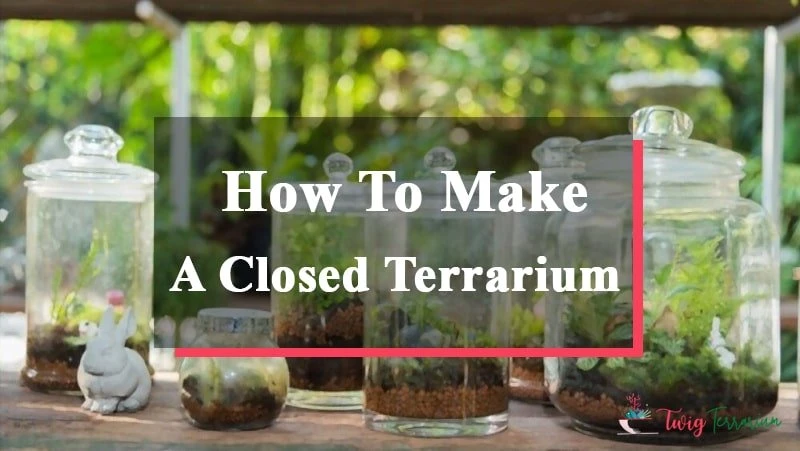reviewed by Truman Perkins
Recently, it has become increasingly common to see beautiful pictures of terrariums with plants on the Internet. Many of them are almost works of art – with a plot, character figures, and tiny copies of objects. Such a thing may seem very complicated in execution and fastidious in care, but it is not so if guided by a few tips. In general, a glass container in which plants suitable for such conditions grow can become an independent ecosystem. Of course, it is not airtight; it is necessary to water the miniature garden from time to time, but water evaporates much slower, and moisture-loving plants feel well in such a microclimate.
Contents

As for the owner of this miniature garden, contemplating a terrarium created by your own hands will certainly be no less calming for him than meditation. In 5 steps, you can start making a masterpiece like this.
There’s no need for a roomy aquarium, an expensive mini greenhouse, or even a ready-made terrarium kit. Virtually any glass vessel will do – from small bulk containers to a small round aquarium, usually kept goldfish. In short, the only limit is your imagination.
Rinse your future terrarium with disinfectant to remove potential moss spores or substances that would be harmful to the plants. Allow the vessel to dry completely for 1-2 days before filling it with drainage, soil, and plants.
As terrariums do not have drainage holes, this should be taken into consideration while preparing the substrate. Make a 3-5 cm layer of gravel at the bottom of the tank. Before adding soil, place sphagnum moss or burlap on the surface of the first layer – these components will prevent the substrate from falling between the stones and caking. If moss is your choice, remember to wash it first to remove any seeds, weeds, or insects that may be in it. It should be laid in small pieces, not as a single layer, as the manufacturer packaged it.
The next layer is made of charcoal with a thickness of 0.5-1.5 cm. It is necessary for disinfection and neutralization of odor in case you overwater. And then comes the turn of soil – a layer of 6 cm will be quite enough. Depending on the depth of the terrarium, the amount of substrate can be varied by sticking to the above proportions.
There is usually a choice between flowering and deciduous plants for terrariums. Today, many flower stores offer a large selection of miniature plants that are ideal for the size of the container. The most popular of them are Scindapsus, ferns, and ivy, and decorative types of moss. For example, yagel acts as a bright and unusual spot of color, contrasting with the rest of the green mass. When choosing plants, keep in mind that they should all have similar lighting needs and watering frequencies.
You can also use different branches and rocks for a more interesting solution. And to create a terrarium with a story, you can make small benches, add figurines of people, animals, and reduced copies of objects.
By the way, if you are afraid that because of the high humidity, a gnat will settle in the terrarium, cover its edge with gauze and fasten it with a rubber band.

Maintain optimal humidity levels in the terrarium and do not let the substrate get sour or dry. Replace watering by sprinkling from time to time after planting and from time to time afterward. If you think the flowers need more moisture, water them but do it moderately. Don’t forget that too much water in the terrarium causes fungal diseases, mold, rotting plants. If these problems appear, it will not be easy to cope with them.
Terrarium with plants: Condensation on the terrarium walls is normal as long as there is not too much condensation. If you can hardly see through the condensation, it is a good reason to waterless. Tanks with a lid should be ventilated more often to get the extra water to evaporate. Opened terrariums reach normal humidity levels faster. However, they require more frequent watering than lidded ones. After a while, the ecosystem will normalize, and you can go back to your usual care.
If you notice fungus spreading on the ground’s surface and the plants, take the same measures. Some fungi can be removed with tweezers or wooden sticks. And don’t forget to get rid of withered leaves and inflorescences – rotting away often leads to fungus.
Twice a year, apply a small amount of fertilizer in pellets. Trim or thin out the plants, so they don’t overgrow and get in each other’s way.
Direct sunlight can be devastating to plants in a terrarium, causing rot and fungal diseases to develop. Also, in this environment, the temperature rises quite quickly in the sun, and without airing, the roots can boil over. Therefore, the best place for a terrarium will be one with enough diffused light. And you should definitely not choose southern and western windows.

How to make an enclosed terrarium in a bulb with your own hands. At first sight, it is not possible to make an eternal terrarium that does not require maintenance. Still, there are many examples of closed micro-ecosystems in wildlife, for example, the closed world of caves or wells, hollows inside a tree. But not everyone can see the macrocosm of such a system with his own eyes. Still, everyone can try to create with his own hands a terrarium that does not require maintenance, for example, inside an ordinary electric light bulb.
It would be best to create a perpetual terrarium normal electric light bulb, preferably 200-300 watts, but for lack of such will do and 95 watts, pliers, screwdriver, tweezers, glue sealant, and PVA, basic protective equipment in the form of glasses and gloves.
And so proceed to manufacture a perpetual terrarium in an ordinary light bulb with their own hands, not requiring maintenance.
But this is the finished composition of a terrarium from a light bulb with his hands. The result of our experiment to create a perpetual terrarium in a light bulb.
By sealing in a hermetically sealed terrarium, arranged in an ordinary electric light bulb, a closed ecological environment is formed, with the circulation of metabolism, oxygen, and carbon dioxide. As you can see, it is straightforward to create at home, a small planet, a macrocosm with its own natural conditions, living in a terrarium with its own life without your intervention. Of course, something in such a world may die, but other plants and microorganisms will adapt and live forever without your intervention. It is so easy to make an eternal terrarium with your own hands and without maintenance.
 |
 |
 |
 |

About Truman Perkins
Truman Perkins is a Detroit-based SEO consultant who's been in the business for over a decade. He got his start helping friends and clients get their websites off the ground, and he continues to do so today. In his free time, Truman enjoys learning and writing about gardening - something he believes is a natural stress reliever. He lives with his wife, Jenny, and their twins in Detroit.
 |
 |
 |
 |
Get new FREE Gifts. Or latest free growing e-books from our latest works.
Disable Ad block to reveal all the links. Once done, hit a button below
 |
 |
 |
 |